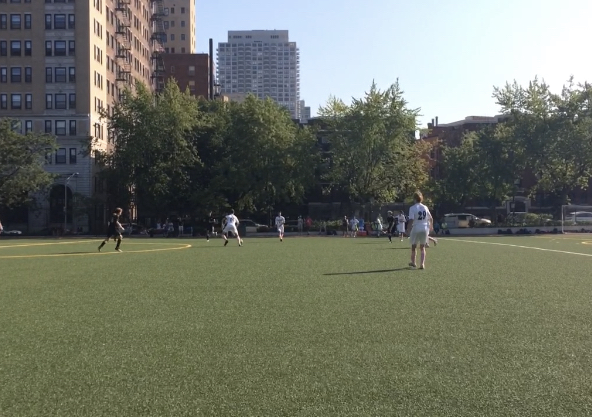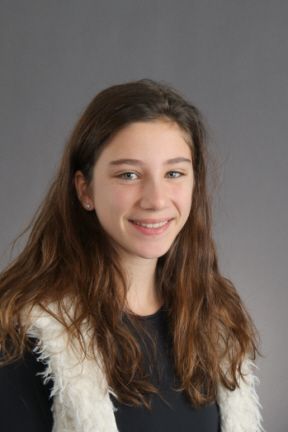Where Are We Now?
Absence Of Lights On The Field

Last years’ boys’ Varsity Homecoming game on the field, on which there are currently no lights. Photo by Jared Saef.
As a new school year commences, the fall sports teams will soon be putting their preseason practice to the test. Many of these games and practices take place hours after the school day ends, at times leaving athletes to play into the evening hours. For this reason, the idea of lights on the field remains a perennial topic of interest to the Parker community. The administration continues to balance the safety of its students with its desire to satisfy concerns of its neighbors. Today there are no lights on the field because of concerns raised by 43rd ward neighbors, which ultimately put a pause on Parker’s plans in 2012.
The lack of lights has caused some frustration among the Parker students and faculty. “I’ve been in a couple of games when I was on JV field hockey where they were cut before the actual end. It was very annoying,” said a rising Parker junior, who wishes to remain anonymous. While the athletic department works hard to fit in the necessary games, some still take place around dusk. Parker’s policy is to cut these games short before the darkness becomes a safety hazard. “It’s not really fair, everyone should be able to finish out whatever game or match they’re in. The lights wouldn’t even be on that late.”
The controversy over lights on the turf field first surfaced in 2011– back when this year’s seniors were in 4th grade. Parker developed the Everybody Plays field enhancement project, which included plans to install a turf field, a track, and stadium lights on its Lincoln Park field. The lights would have involved four 6-story light towers, consisting of approximately 100 lights total. They would turn on as early as 4:30 pm and turn off as late as 9:00 pm and have Spill Guard Visors and internal louvers to minimize the spill of light beyond the field.
At the time the project was announced, the Parker administration provided information on their website to inform the public of its plans and reasons for expanding the field’s use. “The school’s emphasis on the physical well-being of its students as well as the inclusive tradition of the athletic program has led to notably high use of the field,” the website said, “a level of use which the current field cannot safely support.”
As reported last year in The Parker Weekly, the school’s announcement regarding the stadium lights sparked neighborhood opposition, leading to the formation of an organization known as “Francis Parker Neighbors” (FPN). The opposition group quickly gained supporters through a petition drive and website, as well as endorsements from all five aldermanic candidates for the 43rd ward, including the current alderman, Michele Smith.
Conversations between the school and the community continued throughout 2012, leading Alderman Michele Smith to convene a “Community Relations Committee composed of Parker officials, residents from neighboring buildings, and Parker parents” that meets quarterly. They debated the necessity of the lights, how they would affect traffic, and whether or not third-party rentals would be permitted.
“Parker makes the puzzling claim that because the lighting project will be focused on their students, there will be no new traffic problems. But won’t the new nighttime athletes have to be delivered and picked up from evening play, recreating the familiar morning and afternoon traffic jam?” FPN said back in 2011. “Once this is no longer an after school event, will families attend practices? If there are games, who will come to watch them? What about the audience, opposing teams, and their spectators? Where will all of these people park?”
In 2012, neighbors, Parker, and Alderman Smith reached a final agreement in the form of a City of Chicago Planned Development Ordinance that outlined the use and restrictions regarding Parker’s grounds. Specifically, it states that 1) there will be no permanent field lighting, 2) the school may not use temporary lights to bypass the city ordinances prohibiting field lighting, and 3) Parker may lease the new turf field, but only for the use of people aged 18 and younger and not past 7:30 PM.
Within the Parker community, most are in full support of lights yet also understand the opposing perspective. Sophomore Aidan Young, who does not use the field for sports practice, is on the fence on whether or not lights are necessary. “I can understand both sides,” Young said. “Part of our mission is to strive to be the best members of our community, which means being courteous to our neighbors.”
Parker’s newly elected Student Athletic Council (SAC) committee head, Senna Gardner, is in full support of lights. “I think that lights on the field will help the athletic department fix scheduling problems that we have dealt with for many years,” Gardner said. “They can also allow for more home games to be scheduled for a certain day. That would mean that less teams have to travel far distances for away games and therefore have more time for homework and other things. I know [the neighbors] are concerned about noise, light pollution, and traffic but I think that all of these issues can be addressed.”
Parker’s Athletic Director, Bobby Starks, believes that although lights would be a huge gamechanger, they’re not of the utmost importance. “I wouldn’t say we need lights, it’s not a necessity,” Starks said. “We have a wonderful field and we’re able to do pretty much what we need to do within the confines of the daytime. However, I think the lights would be a huge added benefit to not only our sports and athletics program but also an added benefit to the school.”
Coach Misha Geller, who coaches high school field hockey, has a different point of view. “We don’t need lights but it definitely keeps us out of postseason hosting, which is no help to our reputation in the greater field hockey community of the state.”
She believes that the neighbors don’t clearly understand Parker’s terms. “Our school has been here for over 100 years and the community concerns with our field usage is unfair as we’ve demonstrated responsibility for the better part of a century. I would love the field to have lights. Our schedules would be better and we would definitely have more wiggle room with moving our schedule around if need be.”
With regard to scheduling, it is manageable in the current confines of daylight, however certain times of the year are harder than others. “As we get closer to mid-September and October, obviously the darkness sets in a little bit earlier,” Mr. Starks said. “At some point, we have to get our varsity game in and with the time left over those JV and middle school players might have to play shortened games.”
Another Parker employee, who spoke on the condition that they remain anonymous, raises strong safety concerns and agrees that the lights would be a strong benefit for the school. Though Parker takes extensive measures to increase safety, such as using neon balls, accidents can still occur. They can think of “two instances where soccer players have gotten hit in the head with a ball because they couldn’t see it [due to the low light condition]. One of the players actually had to have an ambulance called because she was badly concussed to where she couldn’t remember where she was at.”
The issue of lights has been settled since the 2012 agreement with neighbors. The only way Parker could obtain lights in the future would be to follow the process outlined in the Planned Development Ordinance and seek approval through the Chicago Zoning Administrator (as outlined in Chicago Zoning Ordinance Section 17-13-0602). This issue is linked to “the citizenship [Parker] teaches… they’re part of a larger group,” Alderman Michele Smith said this past summer. “It’s really a community decision.”
Though Parker didn’t get the lights, “we have a huge competitive advantage because we have a turf field,” Mr. Starks said. “I think with lights, most high schools don’t really have too many lights. There are different stakeholders: the alderman, the neighborhood associations. Sometimes having more people sitting at the table, it makes a longer process because everybody has to buy into it. And, unfortunately, we haven’t reached that yet but each year it is a topic that we continue to bring up for consideration.”







